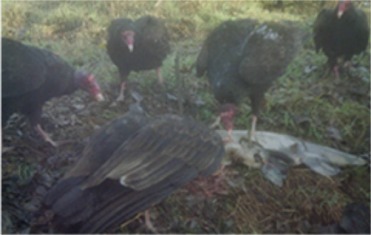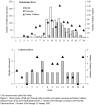Because of their large populations and
body sizes, Pacific salmon are a major source of food for terrestrial and
aquatic organisms associated with spawning streams, from bears to bacteria.
Pacific salmon spend most of their life cycles as top predators in the
nutrient-rich North Pacific Ocean, where they incorporate carbon, nitrogen,
phosphorus, and other micronutrients into their body tissues.
Until recently, these processes had
really only been studied in the more pristine areas of the Pacific
Northwest. Dr. Peter Moyle,
of UC Davis, and I wanted to see if pathways for salmon-derived
materials still functioned in highly modified salmon stream ecosystems
of California's Central Valley.

These tissues provide an important
nutrient and energy subsidy to oligotrophic streams where they spawn and
eventually die. Spawning salmon release nutrients into streams through
normal metabolic processes, release of gametes, the consumption of salmon
flesh by numerous organisms or the decay of carcasses.
A large female Chinook salmon in the Mokelumne River
(Click on image to enlarge). Note the large puncture wounds indicating
a narrow escape from a sea lion.
Recently, the use of stable isotopes to
trace trophic pathways has revealed that marine-derived nutrients from
Pacific salmon are transferred not only into aquatic ecosystems, but into
adjacent terrestrial ecosystems. The large difference in heavy isotope (e.
g., 15N and 13C) composition of salmon tissue relative
to freshwater or terrestrial values has been used to estimate the proportion
of salmon-derived N or C in animal tissues, invertebrates, biofilms, and
plant communities. Thus, stable isotope analysis provides a means for
tracing marine elements from spawning salmon through the trophic systems of
the streams they use, as well as those of adjacent terrestrial systems.
Marine derived nitrogen (MDN) has been found in riparian vegetation tissue
far from river banks. Observations of MDN signatures in bird guano, adult
aquatic insects, and terrestrial vertebrate scat and urine suggest a pathway
of nutrient transport from salmon tissue to terrestrial systems beyond
simple transport through root systems of trees.
Salmon carcasses play an important role
in the behavior and ecology of many terrestrial consumers. Densities of many
vertebrates increase around streams in which salmon are spawning as they
move in from surrounding areas to feed on the salmon. This can have a
profound effect on salmon nutrient dispersal. Terrestrial scavengers may
move 58% to 90% of all salmon biomass to land, sometimes hundreds of meters
from the stream, providing a transport mechanism for as much as 85% of MDN
uptake of riparian foliage within 0.5 km of the spawning channel.
The salmon subsidy results in an increase
in the abundance and growth rates of aquatic invertebrates and fish and
riparian tree production. In this context, salmon nutrients are part of a
positive feedback loop, because juvenile salmon grow faster and have higher
survival rates when their invertebrate prey are abundant in streams and
riparian areas. The complexity of stream habitat, important for both
juvenile and spawning salmon, also increases when large, salmon-fertilized
trees fall into the water.
Using a combination of
tissue
samples, salmon surveys, and infrared motion detector cameras along the
regulated Cosumnes and Mokelumne rivers, we found some interesting results:
We observed 14 terrestrial vertebrate
species, including “herbivores” such as mule deer (Odocoileus hemionus) and
western gray squirrels (Sciurus griseus), feeding directly on salmon
carcasses. Although the lower Mokelumne River (LMR) drainage has lost large
vertebrate scavengers, such as bears (Ursus spp.), wolves (Canis lupis), and
to a great extent, bald eagles (Haliaeetus leucocephalus), domestic animals,
such as cats (Felis domesticus) and dogs (Canis domesticus) and commensal
animals, such as turkey vultures, opossums, and raccoons, continue to
transport nutrients to adjacent agricultural fields, including vineyards.
The distinct differences in carcass consumption rates and scavenger numbers
(mainly turkey vultures) between the Mokelumne and Calaveras rivers suggest
that the nutrient transport system observed in more pristine systems
continues to function in highly modified systems if the salmon runs also
continue. In fact, we detected significant amounts of marine derived
nutrients in riparian foliage, including vineyards, along the regulated
lower Mokelumne River (LMR) that supports a robust salmon run.
If we use the peak estimate of 600 000
California Central Valley Chinook salmon escapement for the year 2001, and
our average N estimate, California runs may actually contribute as much as
6000 metric tons of biomass, 1800 metric tons of C, and 337 metric tons of N
to the Central Valley annually.
Managing regulated rivers for salmon has benefits far beyond simply
providing fish for anglers. The marine derived nutrients of salmon can
positi
vely affect both natural riparian systems and agricultural crops, with
considerable economic benefit; 600 000 salmon could be worth US$186 000-1.06
million as N fertilizer alone.
If you'd like to learn more about
this, our study will be published soon in Ecological Applications
(Winter 2006).







